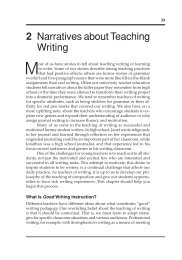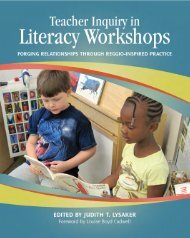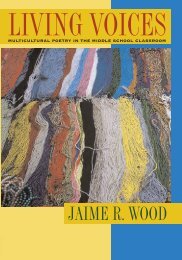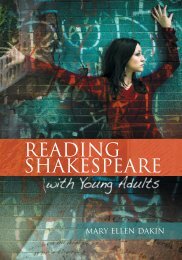Graphic novel Spread - National Council of Teachers of English
Graphic novel Spread - National Council of Teachers of English
Graphic novel Spread - National Council of Teachers of English
- No tags were found...
Create successful ePaper yourself
Turn your PDF publications into a flip-book with our unique Google optimized e-Paper software.
Introduction—Carving a Niche 3<br />
for the classroom, more convincing evidence is in order than what might<br />
be dismissed as a fad or passing spike in a medium’s popularity. Research<br />
and applied examples would help, wouldn’t they The chapters<br />
that follow <strong>of</strong>fer practical ideas and applications from experienced teachers,<br />
pr<strong>of</strong>essors, and education pr<strong>of</strong>essionals for using graphic <strong>novel</strong>s in<br />
conjunction with printed texts you might already be exploring with your<br />
students. Many <strong>of</strong> the contributors presently teach graphic <strong>novel</strong>s in<br />
their classes or have previously done so, and they see young people at<br />
various levels enthralled in these diverse examples <strong>of</strong> sequential art<br />
narratives. Before reading their fine essays, however, consider this introduction<br />
as a glimpse into some <strong>of</strong> the most salient current research<br />
on the utility <strong>of</strong> comics and graphic <strong>novel</strong>s in education.<br />
An Arts-Rich Education<br />
Recent studies detailing the benefits <strong>of</strong> an arts-rich education suggest<br />
that teachers <strong>of</strong> <strong>English</strong> language arts might want to reexamine how they<br />
incorporate the arts into their pedagogy. The idea is to remember what<br />
John Dewey (1916) said:<br />
Not only is social life identical with communication, but all communication<br />
(and hence all genuine social life) is educative. To be<br />
a recipient <strong>of</strong> a communication is to have an enlarged and changed<br />
experience. . . . The experience has to be formulated in order to be<br />
communicated. The formulate requires getting outside <strong>of</strong> it, seeing<br />
it as another would see it, considering what points <strong>of</strong> contact<br />
it has with the life <strong>of</strong> another so that it may be got into such form<br />
that he can appreciate its meaning. . . . All communication is like<br />
art . . . (http://www.ilt.columbia.edu/publications/dewey.html)<br />
In other words, a good education—one bound in experience and meaning<br />
making—is probably an education that has been enriched with a<br />
broad definition <strong>of</strong> art and culture.<br />
Supporting such a claim is the 1999 report Champions <strong>of</strong> Change:<br />
The Impact <strong>of</strong> the Arts on Learning, which found through multiple extensive<br />
studies that “learners can attain higher levels <strong>of</strong> achievement<br />
through their engagement with the arts. Moreover . . . learning in and<br />
through the arts can help ‘level the playing field’ for youngsters from<br />
disadvantaged circumstances” (Fiske, p. viii). In an era in which closing<br />
the gap is <strong>of</strong> deep import, the study’s finding that “high arts participation<br />
makes a more significant difference to students from low-income<br />
backgrounds than for high-income students” (p. viii) should raise<br />
eyebrows.
















